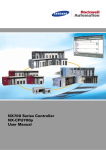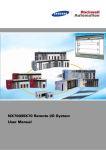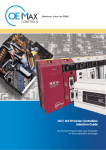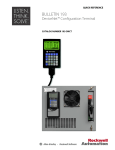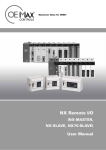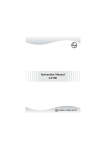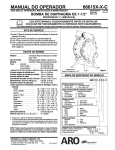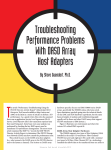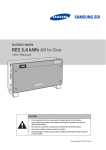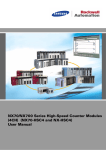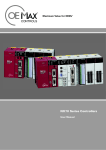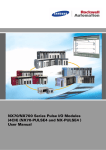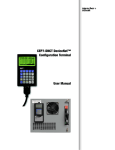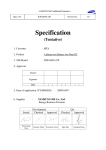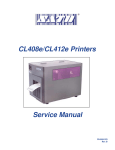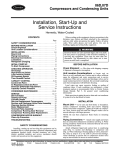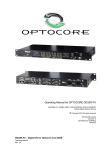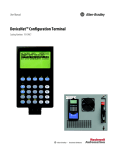Download NX70/NX700 Serial Communications Unit (SCU) User Manual
Transcript
NX70/NX700 Serial Communications Unit (SCU) User Manual Important User Information Solid state equipment has operational characteristics differing from those of electromechanical equipment. Because of these differences, and also because of the wide variety of uses for solid state equipment, all persons responsible for applying this equipment must satisfy themselves that each intended application of this equipment is acceptable. In no event will Rockwell Samsung Automation be responsible or liable for indirect or consequential damages resulting from the use or application of this equipment. The examples and diagrams in this manual are included solely for illustrative purposes. Because of the many variables and requirements associated with any particular installation, Rockwell Samsung Automation cannot assume responsibility or liability for actual use based on the examples and diagrams. No patent liability is assumed by Rockwell Samsung Automation. with respect to use of information, circuits, equipment, or software described in this manual. Reproduction of the contents of this manual, in whole or in part, without written permission of Rockwell Samsung Automation. is prohibited. Throughout this manual we use notes to make you aware of safety considerations. WARNING IMPORTANT ATTENTION Identifies information about practices or circumstances which may lead to serious personal injury or death, property damage, or economic loss. Identifies information that is critical for successful application and understanding of the product. Identifies information about practices or circumstances that can lead to minor personal injury, property damage, economic loss, or product malfunction. However, depending on circumstances, failure to follow the directions accompanying this symbol may also lead to serious consequences. Contents 1. Specifications and Components ................................. 9 SCU Features .................................................................................................. 9 System Configuration................................................................................... 10 Specifications ................................................................................................ 11 Unit Diagram ................................................................................................. 12 Operation Status Display and Functions .................................................... 13 DIP Switch Settings ...................................................................................... 14 2. Wiring........................................................................ 17 Wiring ............................................................................................................ 17 3. Operations and Programming Examples................... 19 Basic Operations ........................................................................................... 19 Precautions for SCU Operation ................................................................... 20 Programming ................................................................................................ 22 NX70, NX700 PLC Installation Example...................................................... 33 PLC Programming Examples ....................................................................... 34 Troubleshooting............................................................................................ 47 4. Product Dimensions and Installation........................ 51 NX700 PLC Product Dimensions ................................................................. 51 NX70 PLC Product Dimensions ................................................................... 53 Power Unit Dimensions(mm) ...................................................................... 54 3 4 Safety Instructions Please read this manual and the related documentation thoroughly and familiarize yourself with product information, safety instructions and other directions before installing, operating, performing inspection and preventive maintenance. Make sure to follow the directions correctly to ensure normal operation of the product and your safety. Otherwise it may cause overheating and product WARNING • If this product is used in a situation that may cause personal injury and/or significant product damage, implement safe measures such as use of fault-safe equipment. • Do not use this product under any conditions exposed to explosive gases. It may cause an explosion. ATTENTION • Make sure to use an external device when configuring the protective circuit breakers for emergencies or interlock circuits. • Fasten the terminal screws tightly to ensure that the cable connection is secure. Incorrect cable connection may cause overheating and product malfunction. • Operate and keep the product under the allowed conditions directed in product specifications. Otherwise it may cause overheating and product malfunction. • Do not disassemble or remodel the product. Otherwise it may cause an electric shock or malfunction. • Do not touch the terminals when the power is on. Otherwise it may cause an electric shock. 5 Installation Environment for SCU (Serial Communication Unit) ATTENTION Do not install your analog conversion modules if any of the following conditions are present: • Ambient temperature outside the range of 0 to 55 °C (32 to 131 °F). • Direct sunlight. • Humidity outside the range of 30% to 85% (Noncondensing). • Chemicals that may affect electronic parts. • Excessive or conductive dust, or salinity. • High voltage, strong magnetic fields, or strong electromagnetic influences. • Direct impact and excessive vibration. ATTENTION Installing the SCU Module on the System 1. Connect a communication cable to the SCU module. 2. Turn on the power to the external device connected to the SCU module. 3. Turn on the main PLC power. ATTENTION Removing the SCU Module from the System 1. Turn off the main PLC power. 2. Turn off the power to the external device connected to the SCU module. 3. Remove the communication cable. 6 ATTENTION Preventing SCU Module Malfunctions • Be sure to power off the PLC system before installing or removing an SCU module. • Ensure that the SCU module is secured onto the backplane before operating it. • Be cautious of metal chips when wiring for the SCU module. Metal chips and debris that fall into the module can cause damage. • Do not touch with your hand the connector on the bottom of the module which is used to connect to the backplane . Otherwise, it can cause connection fault and static electrical discharges. • Do not drop or impose impact to the SCU module. It can cause damage because the housing is made of injection-molded plastics. ATTENTION Preventing PLC System Malfunctions • Use an isolation transformer and line filter on the incoming power to the PLC when there is equipment using or producing high current, high voltage, or large magnetic fields in the vicinity. • Use analog sensor that meets the rated specifications for module connection. Otherwise, it may cause operation errors. • Separate the main PLC power line ground from all other power grounds. Always use class 3 grounding. • Do not exceed the current and power rating of the external 24 VDC provided by the PLC power supply. • Avoid system faults due to programming errors by reading and fully understanding this system manual and the PLC instruction set. • Perform regular preventive maintenance on installed systems, checking devices and wiring for potential breakdowns and failures. 7 8 1 Specifications and Components Exchange data with RS232C or RS485 communication devices, such as barcode reader (RS232C) and network inverter (RS458). ASCII and HEX (Binary) data transfer is enabled with ladder program. (SCU unit = the existing features of SDU unit + 485 communication) Read data with the advanced instruction, READ NX70 PCL SCU Unit (NX70-SCU) NX700 PCL SCU Unit (NX-SCU) Write data with the advanced instruction, SCU Features 1. Two channels are implemented on a single unit (RS232C, RS485 selectable). 2. Data input/output with simple sequence instructions. Use PLC advanced instruction READ to read data from the SCU, and WRITE to write data to the SCU. CPU unit and SCU will handle the task with shared memory, so there is no need for writing complicated programs. 3. SCU unit is equipped with RS-485 network feature, added to the existing N-series SDU module features, expanding its scope of usage. 4. RS232C or RS485 communication network is available. Data input/output with RS232 devices: Connect to and exchange data with devices like IDX display, measurement instrument, barcode reader, and printer. Data input/ output with RS485 devices: Connect through network to temperature controller, network inverter, and network servo. 5. Unlimited mounting in PLC slots, 500 byte transmission capability. 9 6. Both ASCII and HEX (binary) can be used as transmission code. 7. End code can be configured freely with PLC ladder instructions. NOTE In addition to this Manual, please refer to System Manual and Programming Manual for the PLC when using SCU. System Configuration Using RS232C Communication Barcode Reader ID Card RS-232C Cable Printer Measurement instrument Using RS485C Communication RS-485 communication Inverter network RS-485 communication Temperature controller network You can connect RS232C device/RS485 network device to each RS232C/RS485 (CH1, CH2) channel. NX series SCU can be mounted anywhere you want regardless of whether the backplane is base or expansion. The number of SCU mounting is not limited. 10 Specifications General Specifications Item Temperature Specifications Operating 0 °C to +55 °C (32 °F to 131 °F) Storage -25 °C to +70 °C (-13 °F to 158 °F) Operating 30 to 85% RH (Non-condensing) Humidity Storage 30 to 85% RH (Non-condensing) Withstand voltage 500 V ac for 1 minute between I/O terminal (dc) and frame ground (power unit) Insulation resistance 100 MΩ or more at 500 mega V dc between I/O terminal (dc) and frame ground (power unit) Vibration immunity 10 to 55Hz, 1 cycle/minute: double amplitude of 0.75 mm, 10 minutes on 3 axis (X,Y, Z) Shock immunity Peak acceleration and duration 15g/11 ms, 3 times in each X, Y, Z direction Noise immunity 1500 Vp-p with 50ns to 1µs pulse width (generated by noise simulator) Ambience No corrosive gas, no excessive dust Occupied I/O points 32 points (16 points input, 16 points output) Max. number of unit Unlimited Performance Specifications Item Specifications Interface RS232C/RS485 2 ports Transmission speed Configured with DSW1 and DSW2 1) Using RS232C: 300/600/1200/4800/9600/19200/38400bps 2) Using RS485: 4800/9600/19200/38400bps Communication method Half duplex Synchronization method Start-stop method Transmission distance Using RS232C: 15m (MAX), Using RS485: 1.2 Km Transmission code ASCII or HEX (Binary) STOP bit 1bit/2bit Transmission data format Parity (even/odd) Data length 7bit/8bit Data transmission order From bit 0, by each character Transmission unit A message, to the end code (length adjustable) Max. message length MAX. 500 Byte/frame (including end and start codes) Interface with CPU unit Shared memory type: N-series: Read and write data with advanced instructions F150 (READ) and F151 (WRITE). Read and write data with advanced instructions READ and WRITE. I/O allocation 16 points input and 16 points output allocated. End code setting Select from three types of c cr d cr+LF e ETX or set arbitrary code from shared memory. Start code Start code Other special controls End code cut transmission mode (control by sequence instruction), Convenient for printing out. Soft reset (control by sequence instruction) NOTE SCU module is configured as 32 points I/O module with 16 points input and 16 points output. (For N-series, I/O is allocated by WinFPST S/W and registered as 16SX and 16SY.) 11 Unit Diagram Front View NX700 SCU (NX-SCU) NX70 SCU (NX70-SCU) Operation status display Reset switch Forced reset on the SCU. RS-232C/485 Interface (CH1) RS-232C/485 Interface (CH1) Inside View NX700 SCU (NX-SCU) ON ON ON 1 2 3 4 5 6 7 8 1 2 3 4 5 6 7 8 1 2 3 4 5 6 7 8 DSW1 DSW2 DSW3 Dip Switch (for CH1, CH2) NOTE 12 Dip switch is located on the bottom of NX70 SCU (NX70-SCU). Operation Status Display and Functions SCU operation and communication status is displayed on the LED on the top of the front panel. SCU front display window NX-SCU NX70-SCU NX700 SCU (NX-SCU) SCU ALARM SD2 RD2 ERR2 SCU PWR SD1 RD1 ERR1 PWR SD1 RD1 ERR1 ALARM SD2 RD2 ERR2 NX70 SCU (NX70-SCU) Implications LED items Power (PWR) Function ● (On): Unit in operation ○ (Off): Power turned off ● (On): Operation error Operation error (ALARM) Turned on when watchdog timer identifies an error. (Press the Reset switch to turn off.) ○ (Off): Normal operation CH.1 CH.2 NOTE Sending data monitor (SD 1) ◎ (Flickering): Sending data ○ (Off): No sending data. Receiving data monitor (RD 1) ◎ (Flickering): Receiving data ○ (Off): No receiving data. Communication error (ERR 1) ● (On): Communication error ○ (Off): Normal communication Sending data monitor (SD 2) ◎ (Flickering): Sending data ○ (Off): No sending data. Receiving data monitor (RD 2) ◎ (Flickering): Receiving data ○ (Off): No receiving data. Communication error (ERR 2) ● (On): Communication error ○ (Off): Normal communication • Communication error LED (ERROR LED) turns on when parity or framing error occurs. Receiving: Parity, framing ERROR Sending: No end code • Communication error LED turns off when normal frame is received or sent (writing to shared memory). 13 DIP Switch Settings CH1 Setting DIP Switch is located inside the SCU. CH1 setting Start code Data length Parity Control setting code Stop Parity bit Check BaudRate Data length Xpara -meter End code BaudRate DSW3 NO NO DSW2 NO DSW1 Start Parity Control code setting code XStop Parity End para bit Check code -meter Bit location1) DSW1 1 2 3 0 0 0 1 0 1 0 1 0 1 0 1 1 0 0 1 1 0 0 0 1 1 1 1 4 5 6 7 8 1 2 3 38400 Bps Transmission speed (BAUD RATE) (see below) 0 1 0 1 0 1 0 1 DSW2 0 0 1 1 0 1 0 1 Parity check (see below) Invalid Valid Parity setting Odd parity (ODD) Even parity (EVEN) STOP bit length 1 STOP Bit 2 STOP Bit Not used Used End code (see below) Set to shared memory (1 byte) CR (0DH) code CR (0DH), LF (0AH) code ETX (03H) code Start code (see below) STX (02H) not used STX (02H) used X-Parameter Not support “0”stands for OFF. “1” stands for ON. ATTENTION 14 7 BIT 8 BIT (CTS, CD) 0 1 0 1 19200 Bps 9600 Bps 4800 Bps 2400 Bps 1200 Bps 600 Bps 300 Bps Data length Control signal (see below) 0 1 1) Function 4 • When using RS485, the available baud rates are 38,400/19,200/9,600/4,800bps. • When parity check is set to Invalid, the parity settings are not applied. • For control signal, the CTS and CD settings can be selected, but set it to Not Applicable when using [3-wire method without flow control]. (using RS232C communication) • Start and end codes determine the start and end of a communication frame. CH2 Setting CH2 Setting Start code Data length Parity Control setting code Stop Parity bit Check BaudRate Data length Xpara -meter End code DSW3 NO NO DSW2 NO DSW1 BaudRate Start Parity Control code setting code XStop Parity End para bit Check code -meter Bit location1) DSW2 1 2 3 0 0 0 1 0 1 0 1 0 1 0 1 1 0 0 1 1 0 0 0 1 1 1 1 4 5 6 7 8 1 2 3 38400 Bps Transmission speed (BAUD RATE) (see below) 0 1 0 1 0 1 0 1 DSW3 7 BIT 8 BIT Parity check (see below) Invalid Valid Parity setting Odd parity (ODD) Even parity (EVEN) Stop bit length 1 Stop Bit 2 Stop Bits (CTS, CD) 0 1 0 1 0 0 1 1 0 1 0 1 19200 Bps 9600 Bps 4800 Bps 2400 Bps 1200 Bps 600 Bps 300 Bps Data length Control signal (see below) 0 1 1) Function 4 Not used Used End code (see below) Set to shared memory (1 byte) CR (0DH) code CR (0DH), LF (0AH) code ETX (03H) code Start code (see below) STX (02h) not used STX (02h) used X-Parameter Not support “0”stands for OFF. “1” stands for ON. ATTENTION • When using RS485, the available baud rates are 38,400/19,200/9,600/4,800bps. • When parity check is set to Invalid, the parity settings are not applied. • For control signal, the CTS and CD settings can be selected, but set it to Not Applicable when using [3-wire method without flow control]. (using RS232C communication) • Start and end codes determine the start and end of a communication frame. 15 EXAMPLE (DSW Settings) CH1 setting CH2 setting Transmission speed: 9600 bps Data length: 8 bit Parity Check : Valid Parity Bit: Odd Stop Bit: 1 Bit Control signal: Not used End code: CR Start code: Not used X-Parameter: Disabled Transmission speed: 9600 bps Data length: 8 bit Parity Check: Valid Parity Bit: Odd Stop Bit: 1 Bit Control signal: Not applicable End code: CR Start code: Not used X-Parameter: Disabled CH1 Setting CH2 Setting Start code Data length End code 16 BaudRate Start Parity Control code setting code XStop End Parity para bit code Check -meter DSW2 NO NO DSW1 Xpara -meter Data length DSW3 NO BaudRate Parity Control setting code Stop Parity bit Check 2 Wiring Wiring RS232C/RS485 INTERFACE SCU Connection Signal PIN NO Signal Name Mnemonic FG 2 SEND DATA SD 3 RECEIVE DATA RD 6789 FRAME GROUND External device 12345 1 Direction SCU Connector (9P) 4 5 SIGNAL GROUND GND 6 485 TRANSIVER- 485- 7 485 TRANSIVER+ 485+ POWER +5V 8 9 ● External device referred above means a variety of RS232 and RS485 devices. ● Typical wiring methods are as follows: 1. RS232 Wiring: 3-wire method without flow control (common wiring method) 2. RS485 Wiring: End termination resistance is built-in. 17 RS232 Wiring Diagram 3-wire method without flow control (RS232 device - 9 pin) SCU (9P) PIN NO RS-232 device (9P) Mnemonic 1 PIN NO Mnemonic 1 FG 2 SD 2 RD 3 RD 3 SD 4 DTR 4 5 SG 5 SG 6 RS485- 6 DSR 7 RS485+ 7 RTS 8 8 CTS 9 9 RI ATTENTION Turn off the DSW1 No. 8 or DSW3 No.4 which are the control codes. 3-wire method without flow control (RS232 device-25 pin) SCU (9P) PIN NO Mnemonic 1 RS-232 device (25P) PIN NO Mnemonic 1 FG 2 SD 2 SD 3 RD 3 RD 4 RTS 4 5 SG 5 CTS 6 RS485- 6 DSR 7 RS485+ 7 SG 8 8 CD 9 20 DTR RS485 Wiring Diagram SCU (9P) PIN NO RS-485 device Mnemonic Mnemonic 6 485+ 485+ 7 485- 485- 1 2 3 4 5 8 9 18 3 Operations and Programming Examples Basic Operations ● You need ladder program to operate the SCU. ● Data exchanges between this unit and CPU unit is transmitted via shared memory. ● Data input from external devices is stored in shared memory only when there is an end code in the data. ● Data is automatically output when written to shared memory. The following diagram shows the data flow in each case of barcode reader connected or printer connected. Connector (9P) SCU Unit C H 1 RS232C (RS485) Drive Receiver 9788940200278 c CPU h d Barcode Reader C H 2 RS232C (RS485) Drive Receiver Shared memory and I/O Printer Connector (9P) Data e Data Memory Backplane connector (50p) CPU Unit *1 Shared memory of SCU enables READ/ WRITE at both the CPU (processor) of the SCU and the CPU(processor) of the CPU unit. 19 f g Data Memory CPU SCU (unit processing) Input to the SCU from external devices Barcode c Reader CPU d Memory e Shared f memory SCU (unit processing) Output from inside the SCU Printer ATTENTION h CPU d Memory e CPU unit (ladder program) g CPU Memory CPU unit (ladder program) Shared f memory CPU g Memory Products like ID-X, where I/O (sending/receiving) passes through only one channel, can be operated as half duplex. The SCU performs communications regardless of PROG/RUN mode, but data transmission is available only in RUN mode. Precautions for SCU Operation For ASCll communication of Rs232C/RS485 ● Errors of transmission processing are reflected at contacts (NX series: X4 to XD, NX plus series: R0.4 to R0.13) so resending with ladder program is recommended. (See below) If an error occurs while the frame is receiving, the frame will be cleared and error LED turns on. But if the next frame is a normal frame, the error LED turns off and the frame is processed as the received frame. ● When the start code is effective, the frame will start at the last receiving start code and end at the end code. [Ex] STX STX ETX STX: Start code ETX: End code Start code is effective: 1 frame Start code is not effective 1. When the end code is not received due to communication trouble, the SCU stands by until the end code is received. 2. You can prevent a prolonged stand-by as follows: Request resending to the external RS232C (RS485) device. If resending is not available at the other RS232C (RS485) device, perform time-up process with ladder program and request resending to the external device. 20 3. The SCU buffer status when resending from the external RS232C (RS485) device is as follows: Start code is not effective STX STX ETX Resent frame Previous frame To shared memory of the received frame Start code is effective STX STX Previous frame ETX Resent frame To shared memory of the received frame ● Software reset is available when resetting the SCU in emergency. 1. Turn Y1D (R1.13) on with ladder program to reset. (Software reset) 2. It takes approx. 1msec from software reset request to complete initialization. 3. XE (R0.14) turns on when initialization completes. ● Ensure the following when set end code with shared memory.(The end code is read from shared memory at every sending and receiving process.) 1. Sending: Set the end code before sending request. 2. Receiving: Set the end code before the external RS232C (RS485) device starts transmission. ● When Y1E (R1.14) → (CH1), Y1F (R1.15) → (CH2) is turned on, the end code transmission can be disabled. (Convenient for output to the printer.) Make sure to turn on Y1E (R1.14) and Y1F (R1.15) before sending request. 21 Programming Send and receive data with CPU unit ladder program for data READ / WRITE with shared memory in the SCU. Two advanced instructions are used for this: READ (F150) and WRT (F151). In addition, handshake for data READ/WRITE will be determined by contact on/off (two points for each X and Y). Data read from special (high-function) unit (F150) Shared memory Data write to special (high-function) unit (F151) High-function unit Register (Word operand) NX Series NX plus series WX, WY..... DT (data) FL (file) Ld (link) R..... M (data) W (file) L (link) CPU unit Special (highfunction) Unit: Special units that include process and shared memory inside the unit. (Ex. SCU, Analog, Location Spotting units) Program Configuration ● A program consists of handshake with shared memory and advanced instructions. See "Timing for Sending and Receiving" on page 25 for detailed information on handshake timing. See "Advanced Instructions" on page 27 for detailed information on PLC advanced instructions. See "Shared Memory Allocation Table" on page 29 for detailed information on shared memory. See "I/O Allocation Table" on page 31 for detailed information on I/O allocation. 22 Using READ in WinFPST (Receiving from external RS232C (RS485) device) When SCU is installed in the first slot of PLC system and external RS232C (RS485) is connected to CH1. X1 X1 Y11 Y11 R100 R100 R100 R101 Condition for READ X1: For CH1 receiving Condition for READ completion X1 turns on when normal data is input to the RS232C (RS485) device connected to CH1. READ Y11: For CH1 receiving When reading received data from shared memory, turn on Y11. Turn on Y11 when X1 is turned off. F150 (READ) (Data READ from high function unit.) R101 Y11 READ completion signal (Output to the SCU unit) Y11 Using WRITE in WinFPST (Transmitting to external RS232C (RS485) device) When SCU is installed in the first slot of PLC system and external RS232C (RS485) is connected to CH1. XO Y1O XO Y1O R103 R103 Condition for WRITE R104 Condition for WRITE completion F151 (WRT) (Data WRITE to high-function unit ) WRITE R103 Y1O 23 R104 Y1O WRITE completion signal (Write to the SCU unit) X0: For CH1 sending When the SCU received correct data, X0 turns on. Y10: For CH1 sending When writing sending data to shared memory, turn on Y10. Turn off Y10 when X0 is turned on. Using READ in WinGPC (Receiving from external RS232C (RS485) device) When SCU is installed in the first slot of PLC system and external RS232C (RS485) is connected to CH1. R0.1 R0.1 R1.1 R1.1 R100 R100 R100 R101 Condition for READ R0.1: For CH1 receiving Condition for READ completion R0.1 turns on when normal data is input to the RS232C (RS485) device connected to CH1. READ R1.1: For CH1 receiving When reading received data from shared memory, turn on R1.1. Turn on R1.1 when R0.1 is turned off. READ (Data READ from high function unit.) R101 R1.1 READ completion signal (Output to the SCU unit) R1.1 Using WRITE in WinGPC (Transmitting to external RS232C (RS485) device) When SCU is installed in the first slot of PLC system and external RS232C (RS485) is connected to CH1. R0.0 R1.0 R0.0 R1.0 R103 R103 Condition for WRITE R104 Condition for WRITE completion WRITE (Data WRITE to high-function unit ) WRITE R103 R1.0 24 R104 R1.0 WRITE completion signal (Write to the SCU unit) R0.0: For CH1 sending When the SCU received correct data, R0.0 turns on. R1.0: For CH1 sending When writing sending data to shared memory, turn on R1.0. Turn off R1.0 when R0.0 is turned on. Timing for Sending and Receiving Regardless of the slot location where the SCU is installed, sending and receiving is available. It is controlled by contacts on/off status. Per each CH, 2 points for sending and 2 points for receiving. (Ex) When installed in slot 0 CH1 For sending CH2 For sending X0 (R0.0) Y10 (R1.0) X2 (R0.2) Y12 (R1.2) For receiving For receiving X1 (R0.1) Y11 (R1.1) X3 (R0.3) Y13 (R1.3) Timing Chart for CH1 using. Sending Data WRITE from PLC CPU to SCU shared memory, and Y10 (R1.0) on/off setting should be controlled by ladder program. Sending SCU starts XO (R0.0) Read from SCU shared memory to SCU CPU, and send it to the external device BUFFER CLEAR Data Y10 (R1.0) Perform with ladder program Data Write data from PLC CPU to SCU shared memory. X0 turns on when the transmission completes with the end code from the SCU to the external device. Receiving Data READ with PLC CPU from SCU shared memory, and Y11 (R1.1) on/off setting should be performed by ladder program. Receiving SCU starts X1 (R0.1) Save data from the external device to shared memory. Data BUFFER CLEAR Y11 (R1.1) Perform with ladder program Data Read SCU shared memory data with PLC CPU unit 25 Timing chart for CH2 using Sending Data WRITE from PLC CPU to SCU shared memory, and Y12 (R1.2) on/off setting should be performed by ladder program. Sending SCU starts X2 (R0.2) Read from SCU shared memory to SCU CPU, and send it to the external device BUFFER CLEAR Data Y12 (R1.2) Perform with ladder program Data Write data from PLC CPU to SCU shared memory. Receiving Data READ with PLC CPU from SCU shared memory, and Y13 (R1.3) on/off setting should be performed by ladder program. Receiving SCU starts X3 (R0.3) Save data from the external device to shared memory. Data BUFFER CLEAR Y13 (R1.3) Perform with ladder program Data Read SCU shared memory data with PLC CPU unit 26 Advanced Instructions Shared Memory instruction - READ in WinFPST [ F150 READ, S1, S2, n, D ] S1: Installation slot number of SCU unit. S2: Starting address of shared memory where source data is stored. n: The number of words of source data to read. D: Starting address of PLC CPU where to store the read data. [Programming Example] RO [ F150 READ, K3, K251, K2, DT15 ] K3: SCU slot (slot 0) K251: SCU shared memory address (Address 251) K2: The number of words of data to read (2 words) DT15: Starting word operand of PLC CPU where to store the read data (DT15) When R0 is on, the SCU shared memory address 251 (CH1 receiving buffer) reads two words of data and send it to NX700 PLC CPU data registers, DT15 and DT16. IMPORTANT 27 • The operands (called device, data, or register in other company’s products) can be divided into bit operand that processes bit information and word operand that processes word information. Word operand: WX, WY, WR, WL, Ld, DT, FL, EV, SV, IX, IY.. I0 to ID Contact operand: X, Y, R, L, T, C... . • F150 (READ) instruction processes word, so 10byte data is processes as 5 words. Shared Memory instruction - READ in WinGPC READ To = RR1 Sz = NR3 Fr = NN5:NR6 NN5 : Slot no. of SCU mounted. (Number, and first I/0 slot start from 0) NR6 : Start address of shared memory of SCU (Word address) NR3 : Number of words to be read RR1 : Start word operand of PLC for storing read data [Programming Example] M0.0 READ To = 2W0 Sz = 2 Fr = 0:251 NN5(0) : Slot no. of SCU mounted. (Slot 0) NR6(251) : shared memory address of SCU (address 251) NR3(2) : the number of words to read (2 words) RR1(W0) : First word operand of PLC to store read data (W0) If M0.0 turns ON , 2 words data is read from shared memory address 251 (CH1 receiving buffer) of SCU installed in slot no.0, and send them to W0 of data register of PLC. IMPORTANT 28 • The kinds of Operand (Data memory) for NX700/ NX70 PLC Data memory : R, L, K, M, F, W, SR .. • As READ instruction is executed in the unit of word, 10 byte data become 5 words Shared Memory instruction - WRITE in WinFPST [ F151 WRT, S1, S2, n, D ] S1: Installation slot number of SCU unit S2: Starting address of the CPU where the input data is stored. n: The number of words of source data to write to the destination. D: Starting address of SCU shared memory where the data will be stored. [Programming Example] RO [ F151 WRT, K0, DT100, K10, K1 ] K0: SCU slot (slot 0) DT100: Starting address of the PLC CPU where the input data is stored. (DT100) K10: The number of words of source data to write to the destination. (2 words) K1: Starting address of SCU shared memory where the data will be stored. (Address 1) When R0 is on, 10 words from NX700 PLC data register DT100 (DT100 to DT109) will be sent to the SCU shared memory address 1 (CH1 sending buffer). Shared Memory instruction - WRITE in WinGPC WRITE To = NN1 : NR2 Sz = NR3 Fr = NN5 NN1 : Slot no. of SCU mounted. (Number, and first I/0 slot start from 0) NR2 :First address to write on the shared memory of SCU. (number/ register) NR3 : Number of words to be written NR5 : First address of data to writes (number/ register) [Programming Example] M0.1 WRITE To = 0 : 1 Sz = 2 Fr = W0 NN1(0) : Slot no. of SCU mounted. ( Slot no. 0) NR2(1) : First address to write on the shared memory of SCU. (address 1) NR3(2) : Number of words to be written (2 words) NN5(W0) : Start word operand of write data (W0) When M0.1 becomes ON, 2 words from data register W0 of NX70/NX700 PLC is transmitted into shared memory address 1 (CH1 transmission buffer) of SCU installed in slot no. 0. Shared Memory Allocation Table SCU has built-in shared memory that is READ/WRITE accessible from PLC CPU unit. Inside the shared memory, the sending and receiving areas are allocated. Therefore, PLC CPU unit and RS232C external devices performs data READ/WRITE through SCU shared memory. 29 Data transmission handshake is processed at PLC contacts on/off (two points for each input and output). Shared memory allocation Address 1 250 251 500 501 750 751 1000 NOTE 30 250 words (500 characters) CH1 sending buffer → RS-232C (RS485) device 250 words (500 characters) CH1 receiving buffer ← RS-232C (RS485) device 250 words (500 characters) CH2 sending buffer → RS-232C (RS485) device 250 words (500 characters) CH2 receiving buffer ← RS-232C (485) device 1001 CH1 end code configuration area 1002 CH2 end code configuration area 1003 CH1 sending data length 1004 CH1 receiving data length 1005 CH2 sending data length 1006 CH2 receiving data length Effective only when DIP SWITCH [shared memory] is set, and set to lower bytes. Effective only when the CH1 communication is set to HEX (BIN). Effective only when the CH2 communication is set to HEX (BIN). Sending buffer area: Data for sending is stored. Receiving buffer area: Received data is stored. I/O Allocation Table The X, Y contact number for I/O is determined by the installation location of the SCU and the number of points of other I/O units. The I/O numbers shown below are applied when the SCU is installed in slot 0 of base backplane. For I/O of SCU, 16 points from X0 to XF will be allocated for input and 16 points from Y10 to Y1F will be allocated for output. The meaning of each I/O contact is shown in the table below and the handshake processing will be based on this status. Input signal N-plus series X0 R0.0 For CH1 sending X0 (R0.0) turns on when the SCU receives sending data. *1 X1 R0.1 For CH1 receiving X1 (R0.1) turns on when normal data is input from devices connected to CH1. *1 X2 R0.2 For CH2 sending X2 (R0.2) turns on when the SCU receives sending data. *1 X3 R0.3 For CH2 receiving X3 (R0.3) turns on when normal data is input from devices connected to CH2. *1 X4 R0.4 For CH1 receiving data X4 (R0.4) turns on only when framing error occurs in received data. X5 R0.5 For CH1 receiving data X5 (R0.5) turns on only when parity error occurs in received data. X6 R0.6 For CH1 receiving data X6 (R0.6) turns on when the received data buffer is full. X7 R0.7 For CH1 receiving data X7 (R0.7) turns on when message length error occurs in received data. X8 R0.8 For CH1 sending data X8 (R0.8) turns on when message length error occurs in sending data. X9 R0.9 For CH2 receiving data X9 (R0.9) turns on only when framing error occurs in received data. XA R0.10 For CH2 receiving data XA (R0.10) turns on only when parity error occurs in received data. XB R0.11 For CH2 receiving data XB (R0.11) turns on when the received data buffer is full. XC R0.12 For CH2 receiving data XC (R0.12) turns on when message length error occurs in received data. XD R0.13 For CH2 sending data XD (R0.13) turns on when message length error occurs in sending data. XE R0.14 For SCU operation ready indication XE (R0.14) turns on when SCU initialization completes. XF R0.15 Unused NOTE 31 Event N-series See "Timing for Sending and Receiving" on page 25 for detailed information. Input signal N-plus series Y10 R1.0 For CH1 sending Y10 (R1.0) turns on when sending data is written to shared memory. Turn off Y10 (R1.0) when X0 (R0.0) is turned on. Y11 R1.1 For CH1 receiving Y11 (R1.1) turns on when sending data is read from shared memory. Turn off Y11 (R1.1) when X1 (R0.1) is turned off. Y12 R1.2 For CH2 sending Y12 (R1.2) turns on when sending data is written to shared memory. Turn off Y12 (R1.2) when X2 (R0.2) is turned on. Y13 R1.3 For CH2 receiving Y13 (R1.3) turns on when sending data is read from shared memory. Turn off Y13 (R1.3) when X3 (R0.3) is turned off. Y14 R1.4 Unused Y15 R1.5 Unused Y16 R1.6 Unused Y17 R1.7 Unused Y18 R1.8 Data format setting of CH1 On for ASCII and Off for HEX (Binary) format Y19 R1.9 Data format setting of CH2 On for ASCII and Off for HEX (Binary) format Y1A R1.10 Unused Y1B R1.11 Unused Y1C R1.12 Unused Y1D R1.13 For software reset SCU is initialized when Y1D (R1.13) is turned on. Approx. 1msec after initialization completes, XE (R0.14) turns on. Turn off Y1D (R1.13) immediately after XE (R0.14) turns on. Y1E R1.14 CH1 If Y1E (R1.14) is turned on before data send request turn in Y10 (R1.0), end code will not be transmitted. Y1F R1.15 CH2 If Y1F (R1.15) is turned on before data send request turn in Y12 (R1.2), end code will not be transmitted. NOTE 32 Event N-series Data error warning signals (X4 to XD, R0.4 to R0.13) turn off when SCU reset switch is pressed or normal data is received. NX70, NX700 PLC Installation Example NX700 PLC system configuration is illustrated below. In this case, the SCU is installed in slot no.4 and I/O units are installed in slot no. 0 to 3. Base backplane (5 slots) 0 1 64 points input (X0 to X3F, R0.0 to R3.15) 32 points input (X40 to X5F, R4.0 to R5.15) 32 points output (Y60 to Y7F, R6.0 to R7.15) 2 3 4 SCU unit 16 points input: X90 to X9F, R9.0 to R9.15 16 points output: Y100 to Y10F, R10.0 to R10.15 16 points output (Y80 to Y8F, R8.0 to R8.15) IMPORTANT 33 • There is no limit on the location and number of SCU installed, and SCU can be installed regardless whether the backplane is base or expansion. • When allocating I/O map with WinFPST, SCU is allocated as "16SX and 16SY". • When allocating I/O map with WinGPC, SCU is allocated as "Both". PLC Programming Examples Self-Test Program for WinFPST Example of ladder program that performs self-loop at the SCU. Convenient program for self-test of the SCU. Operation description Send data from CH1 and receive it at CH2, and compare the sent and received data. Send data from CH2 and receive it at CH1, and compare the sent and received data. Y50 turns on when the compared data are not identical. IMPORTANT • Data WRITE method: WinFPST S/W → on-line → DT0, DT1 and DT5, DT6 at register monitoring. Then, verify data at each of DT10, DT11 and DT15, DT16. (See WinFPST S/W help for detailed information. ) • DIP SWITCH (DSW) setting must be identical at CH1 and CH2, and the setting is arbitrary. • PLC system configuration example shows a NX700 PLC system (NX-CPU700, NX-CPU750A, B, C, or D), with a SCU installed in base backplane slot 3. • Use 9-pin cable when RS232C communication checking at CH1 and CH2 of the SCU, and use 2-pin connection when RS485 communication checking. (See the wiring System Configuration (NX-CPU700, NX-CPU750A, B, C, D) NX-Y16RV RY OUT NX-SCU SCU 34 NX-X16D DC IN Y10 ~ Y1F X20 ~ X2F NX-Y16RV RY OUT X0 ~ XF NX-X16D DC IN I/O allocation CPU NX-CPU750B Base backplane (5 slots) Y50 ~ Y5F SCU X30 ~ X3F Y40 ~ Y4F CH1 and CH2 PIN wiring diagram For RS-232C communication checking SCU (CH1) SCU (CH2) SCU (CH1) SCU (CH2) PIN NO Mnemonic PIN NO Mnemonic PIN NO 1 FG 1 FG 1 1 2 SD 2 SD 2 2 3 RD 3 RD 3 3 4 4 5 5 4 5 35 For RS-485 communication checking 4 SG 5 SG Mnemonic PIN NO Mnemonic 6 6 6 485- 6 485- 7 7 7 485+ 7 485+ 8 8 8 8 9 9 9 9 Sequence Program - ASCII format self-test ladder program (for WinFPST) R9010 Y48 Set CH1 to ASCII mode R9010 Y49 [ F0 [ F0 [ F0 [ F0 MV MV MV MV Set CH2 to ASCII mode H3131, DT0 ] HD, DT1 ] H3232, DT10 ] HD, DT11 ] R9014 DF NSTP 1 NSTP 3 <CH1 sending> SSTP 1 X30 Y40 X30 Y40 R0 R1 (F151)WR R0 K DT K K R0 Slot NO.3 3 0 2 1 R1 Sending from CPU DT0 2 words of data Y40 Y40 is stored to SCU shared memory address R1 NSTP 2 SSTP 2 <CH2 sending> X33 Y43 R2 X33 Y43 R3 R2 (F150 READ) K 3 K 751 K 2 K 5 R2 R3 SCU shared memory From address 751 2 words of data Y43 is stored to PLC CPU DT5 and DT6. Y43 R3 (F60)CMP DT 6 R900B R8 R3 NSTP 1 36 Data comparison Sent data (end code comparison) Received data (end code comparison) DT 1 R3 Slot NO.3 Turns on when the data are not identical. <CH2 sending> Slot NO.3 From PLC CPU DT10, 2 words of data Is stored to SCU shared memory address 501 <CH1 receiving> Slot NO.3 From SCU shared memory address 251, 2 words of data is stored to PLC CPU DT15 and DT16. Data comparison Sent data (end code comparison) Received data 37 Sequence program - HEX format self-test ladder program (for WinFPST) <CH1 sending> From slot NO.3 DT0, 1 word of data is stored to shared memory address 1. From slot NO.3 DT100, 2 words of data is stored to SCU shared memory address 1003 transmission length setting. <CH2 sending> Slot NO.3 From SCU shared memory address 751, 1 word of data is stored to PLC CPU DT5. Data comparison Sent data Received data Turns on when the data are not identical. 38 <CH2 sending> From slot NO.3 DT0, 1 word of data is stored to SCU shared memory address 501. From slot NO.3 DT102, 2 words of data is stored to SCU shared memory address 1005. (transmission length setting) <CH1 receiving> Slot NO.3 From SCU shared memory address 251, 1 word of data is stored to PLC CPU DT15. Data comparison Sent data Received data 39 Self-Test Program for WinGPC Example of ladder program that performs self-loop at the SCU. Convenient program for self-test of the SCU. Operation description Send data from CH1 and receive it at CH2, and compare the sent and received data. Send data from CH2 and receive it at CH1, and compare the sent and received data. R5.0 turns on when the compared data are not identical. IMPORTANT • Write 2-byte data( includes end code "CR") into W0 and W10 before program execution. • The data is written using by WinGPC S/W. • PLC system configuration example shows a NX700 PLC system (NX-CPU700p), with a SCU installed in base backplane slot 3. • Used the same DIP Switch setting for both Ch1 and System Configuration (NX-CPU700p) Base backplane (5 slots) NX-Y16RV RY OUT NX-SCU SCU NX-X16D DC IN NX-Y16RV RY OUT NX-X16D DC IN I/O allocation CPU NX-CPU750B R5.0 to R5.15 R0.0 to R0.15 R1.0 to R1.15 SCU R3.0 to R3.15 R4.0 to R4.15 R2.0 to R2.15 CH1 and CH2 PIN wiring diagram For RS-232C communication checking SCU (CH1) PIN NO PIN NO 1 FG 2 SD 3 RD 5 40 SCU (CH2) Mnemonic 4 SCU (CH1) SCU (CH2) Mnemonic PIN NO 1 FG 1 1 2 SD 2 2 3 RD 3 3 4 4 4 SG For RS-485 communication checking 5 SG Mnemonic 5 PIN NO Mnemonic 5 6 6 6 485- 6 485- 7 7 7 485+ 7 485+ 8 8 8 8 9 9 9 9 Sequence Program - ASCII format self-test ladder program (for WinGPC) <CH1 sending> R3.0 M0.0 R4.0 ( ) R3.0 R4.0 M0.1 ( ) M0.0 WRITE Slot NO.3 To = 03 : 1 save to address 1 of shared memory of SCU Sz = 1 1 word of data Fr =W0 from W0 M0.0 M0.1 R4.0 ( ) R4.0 R3.3 R4.3 R3.3 R4.3 M0.2 ( ) M0.3 ( ) M0.0 <CH2 receiving> READ To = W5 Save to W5 Sz = 1 1 word of data Fr =03:751 from address 751 of shared memory of SCU Slot NO.3 M0.2 M0.3 R4.3 ( ) R4.3 <Data comparison> M0.3 M0.8 ( ) W0 < > W5 sent data 41 received data Turns on when the data are not identical. R3.2 R4.2 M0.4 ( ) R3.2 R4.2 M0.5 ( ) M0.4 WRITE <CH2 sending> Slot NO.3 To = 03 : 501 save to address 1 of shared memory of SCU Sz = 1 1 word of data Fr =W10 from W10 M0.4 M0.5 R4.2 ( ) R4.2 R3.1 R4.1 R3.1 R4.1 M0.6 ( ) M0.7 ( ) M0.6 <CH1 receiving> READ To = W15 Save to W15 Sz = 1 1 word of data Fr =03:751 from address 751 of shared memory of SCU Slot NO.3 M0.6 M0.7 R4.1 ( ) R4.1 <Data comparison> M0.7 M0.9 W10 < > W15 sent data M0.8 M0.9 R5.0 42 ( ) received data M5.0 ( ) Turns on when the data are not identical. Example of Using a Barcode Reader for WinFPST Connect a barcode reader to SCU CH1. (ex. Barcode reader: (Japan) TOKEN THLS-6300) Read barcode information and store it to PLC. Operation description Read the information at the barcode reader connected to CH1 and store it to from PLC DT100. IMPORTANT • The DIP switches (DSW1 and DSW2) are set to 9600 bps, 8 bit, no parity, 1 stop bit, and end code is CR. • SCU is installed in base backplane slot 0 of a NX700 PLC system (NX-CPU700, NX-CPU750A, B, C, D). • Connect SCU CH1 and barcode reader with 9-pin cable. SCU DIP switch (CH1) settings CH1 Setting Baud rate Start Data Parity Control code length setting code End Parity Stop bit code check X-parameter DSW2 DSW1 ON ON NX700 System Configuration (NX-CPU700, NX-CPU750A, B, C, D) SCU X0 to XF Y10 to Y1F Y20 to Y2F Y30 to Y3F Barcode reader (THLS-6300) 43 NX-X16D DC IN 9-pin cable NX-X16D DC IN NX-Y16RV RY OUT NX-Y16RV RY OUT NX-SCU SCU CPU NX-CPU750B Sequence Program – Ladder program example for using a barcode reader (for WinFPST) Set CH1 to ASCII mode setting <CH1 receiving> Slot NO.0 From SCU shared memory address 251, 20 words of data is stored to PLC CPU from DT100 44 Example of Using a Barcode Reader for WinGPC Connect a barcode reader to SCU CH1. (ex. Barcode reader: (Japan) TOKEN THLS-6300) Read barcode information and store it to PLC. Operation description Read the information at the barcode reader connected to CH1 and store it to from PLC DT100. IMPORTANT • The DIP switches (DSW1 and DSW2) are set to 9600 bps, 8 bit, no parity, 1 stop bit, and end code is CR. • SCU is installed in base backplane slot 0 of a NX700 PLC system (NX-CPU700p). • Connect SCU CH1 and barcode reader with 9-pin cable. SCU DIP switch (CH1) settings CH1 Setting Baud rate Start Data Parity Control code length setting code End Parity Stop bit code check X-parameter DSW2 DSW1 ON ON NX700 System Configuration (NX-CPU700p) SCU R0.0 to R0.15 R1.0 to R1.15 R2.0 to R2.15 R3.0 to R3.15 Barcode reader (THLS-6300) 45 NX-X16D DC IN 9-pin cable NX-X16D DC IN NX-Y16RV RY OUT NX-Y16RV RY OUT NX-SCU SCU CPU NX-CPU750B Sequence Program – Ladder program example for using a barcode reader (for WinGPC) R0.1 R1.1 M0.0 0 <CH1 receiving> ( ) R0.1 R1.1 M0.1 3 ( ) M0.0 READ 6 To = W100 Save to W100 continually 20 words of data Sz = 20 Fr = 0 : 251 from address 251 of shared memory of the SCU Slot No. 0 M0.0 16 R1.1 46 M0.1 R1.1 ( ) Troubleshooting 47 48 49 R0.4 (R0.9) R0.5 (R0.10) R0.6 (R0.11) R0.7 (R0.12) R0.8 (R0.13) The SCU is mounted in slot 0, and the contact number in ( ) is the contact number of CH2 error indication. 50 4 Product Dimensions and Installation NX700 PLC Product Dimensions System Dimensions (mm) A B NX-Y16T TR OUT NX-Y16T TR OUT NX-Y16T TR OUT NX-Y16T TR OUT NX-Y32T TR OUT NX-X32D DC IN NX-X64D DC IN NX-X64D DC IN CPU NX-CPU750B 115.5 118.5 unit (mm) Dimensions Slot Types 111.0 A B 3-slot type 205.0 183.8 5-slot type 276.0 254.2 8-slot type 381.0 359.8 10-slot type 452.0 430.2 12-slot type 522.0 500.6 Motherboard Installation Diagram (mm) ¥ı 5.0 * 4 27.5 81.0 L 7.0 22.5 unit (mm) SLOT A L 3-slot type 205.0 153.8 5-slot type 276.0 224.2 8-slot type 381.0 329.8 10-slot type 452.0 400.2 12-slot type 522.0 470.6 A 51 CPU, I/O, Module Dimensions (mm) NX-Y64T OUTPUT NX-X16D INPUT CPU NX-CPU750B 115.5 35.0 104.0 SCU Unit and Special Unit Dimensions (mm) NX-EtherNet EtherNet NX-SCU SCU MWLINK NX-MWLINK AUI 115.5 COM1 RS232C RS485 T + F.G 35.0 52 COM2 RS232C RS485 12V 35.0 35.0 104.0 NX70 PLC Product Dimensions System Dimensions (mm) A 10 5. 0 30.0 38.0 C 4 - M5 B unit (mm) Slot Types Catalog Number Dimensions (A) Dimensions (B) Dimensions (C) 2-slot type NX70-BASE02 149.5 129.5 115.5 3-slot type NX70-BASE03 185.0 165.0 151.0 5-slot type NX70-BASE05 256.0 236.0 222.0 6-slot type NX70-BASE06 291.5 271.5 257.5 8-slot type NX70-BASE08 362.5 342.5 328.5 10-slot type NX70-BASE10 398.0 378.0 364.0 12-slot type NX70-BASE12 433.5 413.5 399.5 53 Power Unit Dimensions(mm) CPU, I/O, Special Unit Dimensions (mm) COM1 RS232C RS485 COM2 RS232C RS485 54 Installation Installation Removal 1. Insert the module holding projector of the module into the module holding groove on the backplane. 1. Unfasten the screw that holds the module in place using a screwdriver. 2. Push the top of the module toward the backplane until it is clamped in place. 2. Hold on pressing the locking button on the edge of the top side of the module, and pull the module from the backplane. Locking Part 3. Ensure that the module is in place onto the backplane, and then fasten the screw using a screwdriver. 1 screw 55 56 NX70/NX700 Serial Communications Unit (SCU) User Manual www.samsungautomation.co.kr Rockwell Samsung Automation Technical Support 447-6, Gongse-Ri, Giheung-Eup, Youngin-City, Gyeonggi-Do, South Korea, 449-902 Tel: 82-31-280-4700 Fax: 82-31-280-4900 Export Sales Team Tel: 82-31-280-4768 Fax: 82-31-280-4900 Trademarks not belonging to Rockwell Samsung Automation are property of their respective companies. Publication RSA-NX700-UM009B-EN-P - July 2005 59 Supersedes Publication RSA-NX700-UM009A-EN-P - March 2005 Copyright © 2005 Rockwell Samsung Automation. All rights reserved. Printed in Korea.


























































